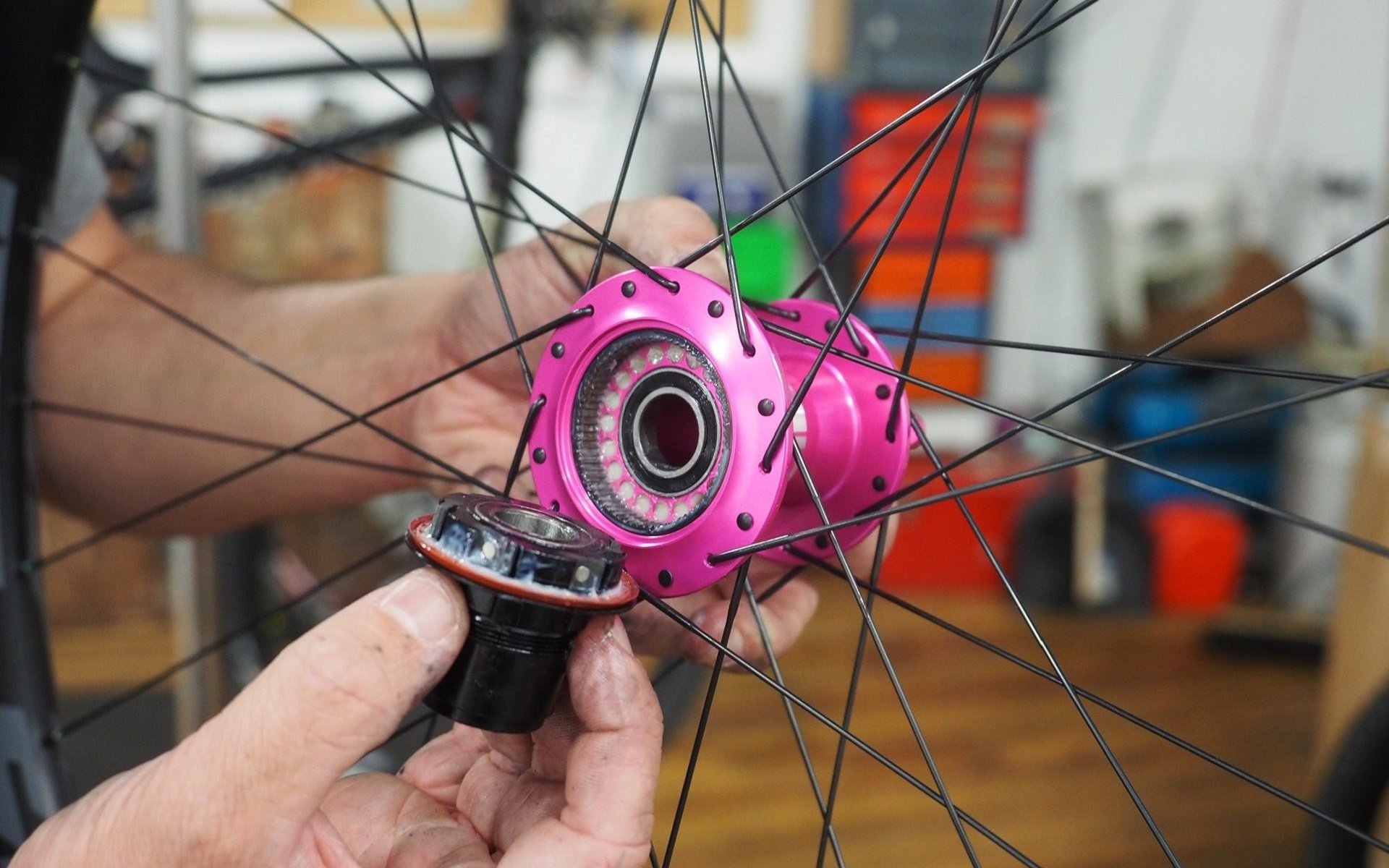
EDITORIAL
Varying Degrees Of Engagement
Zero To Ten
Hub engagement is always a murky and muddled topic to wade into. While ultra-fast-engaging hubs have a passionate fan base, there are many riders who don't belong to said church. Some simply don't know what they don't know, having never experienced near-instant hub engagement. Some ride in terrain where sudden ratchets and thrusts aren't a routine part of mountain bike riding. Some ride exactly where I ride, and how I ride, and are quite happy with lower engaging setups. And, some local folks even prefer a less exact relationship between rotations of the cranks and wheel.
I'm not trying to change anyone's mind. Please, own your experiences. I do not believe that the quickness with which a hub engages, or the novelty of its engagement mechanism, is a key determinant of its relative value. I know from experience that bikes with much less precise power applications are still massive fun to ride in the woods.
But, as someone who jumps back and forth between hubs with radically varying degrees of engagement, it seems to me that discussing where a faster-engaging hub delivers a better riding experience is worthwhile.
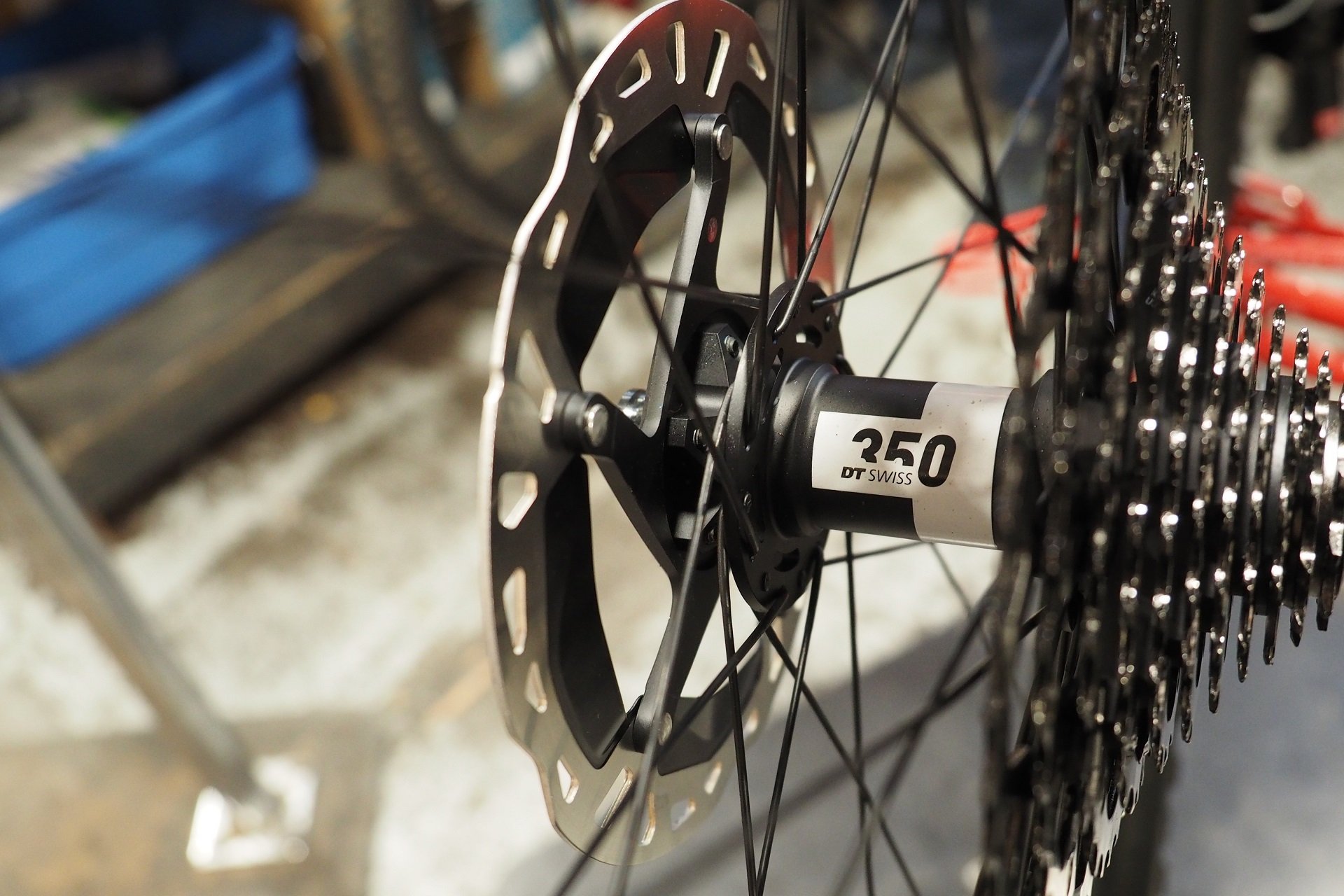
I've been having a blast riding my bikes, both hardtail and full suspension, with this high-quality DT Swiss 350 equipped Reserve Alloy 30 HD wheelset.
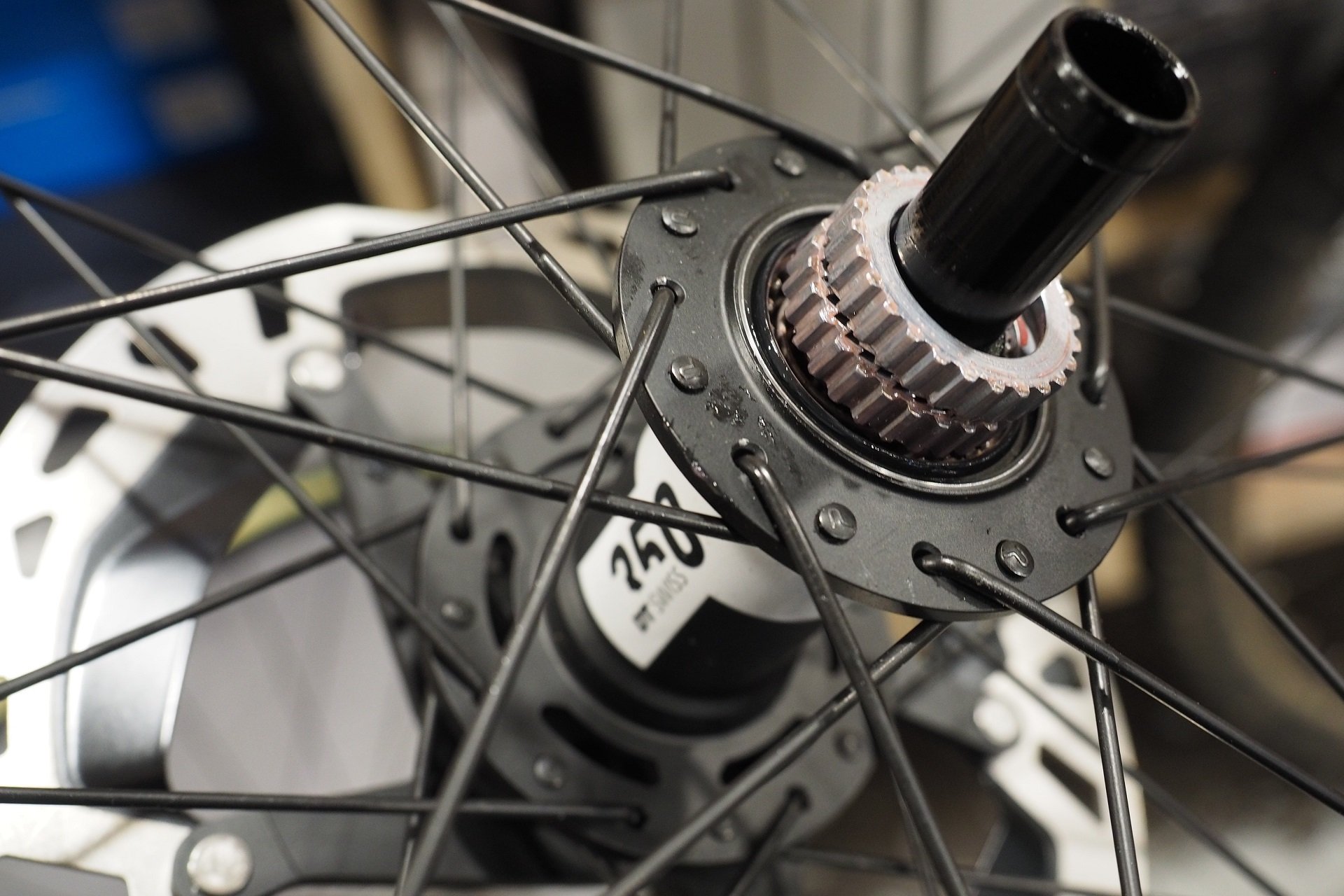
This hub is equipped with a 36t rachet setup, which means it engages in 0-to-10° of rotation. This is DT's best balance of engagement and durability.
For the purpose of this submission, fast-engaging hubs are anything with less than 5° of rotation between engagement points. An Industry Nine 1/1 hub with 0 to 4° between engagement points feels less exact than the same brand's top-end Hydra hub with 0-to-0.52° of rotation between engagement points, but out on the trail, the laws of diminishing returns places these systems in the same category.
Conversely, despite some companies' claims relative to their past products, anything with 0-to-10° or greater engagement, is much less exact in technical terrain without applying some thoughtful techniques. I'll talk more about that below but I'd consider these lower engagement hubs.
Mapped over the last couple of months I can split most of my hours on a bike, on trails, between four different hubs. The Shimano Deore hub on the Trek Roscoe 7 shares the 36pt, 0-to-10°, engagement of the DT Swiss 350 hub I was running on my Marin Rift Zone, and now on my Marin El Roy. My Waltworks V2 was running a pair of Chris King hubs with much faster 72pt, 0-to-5°, engagement. During my last few rides I've been on the Project 321 G2 hubs I started reviewing in October 2017, they feature 216pt, 0-to-1.66°, engagement
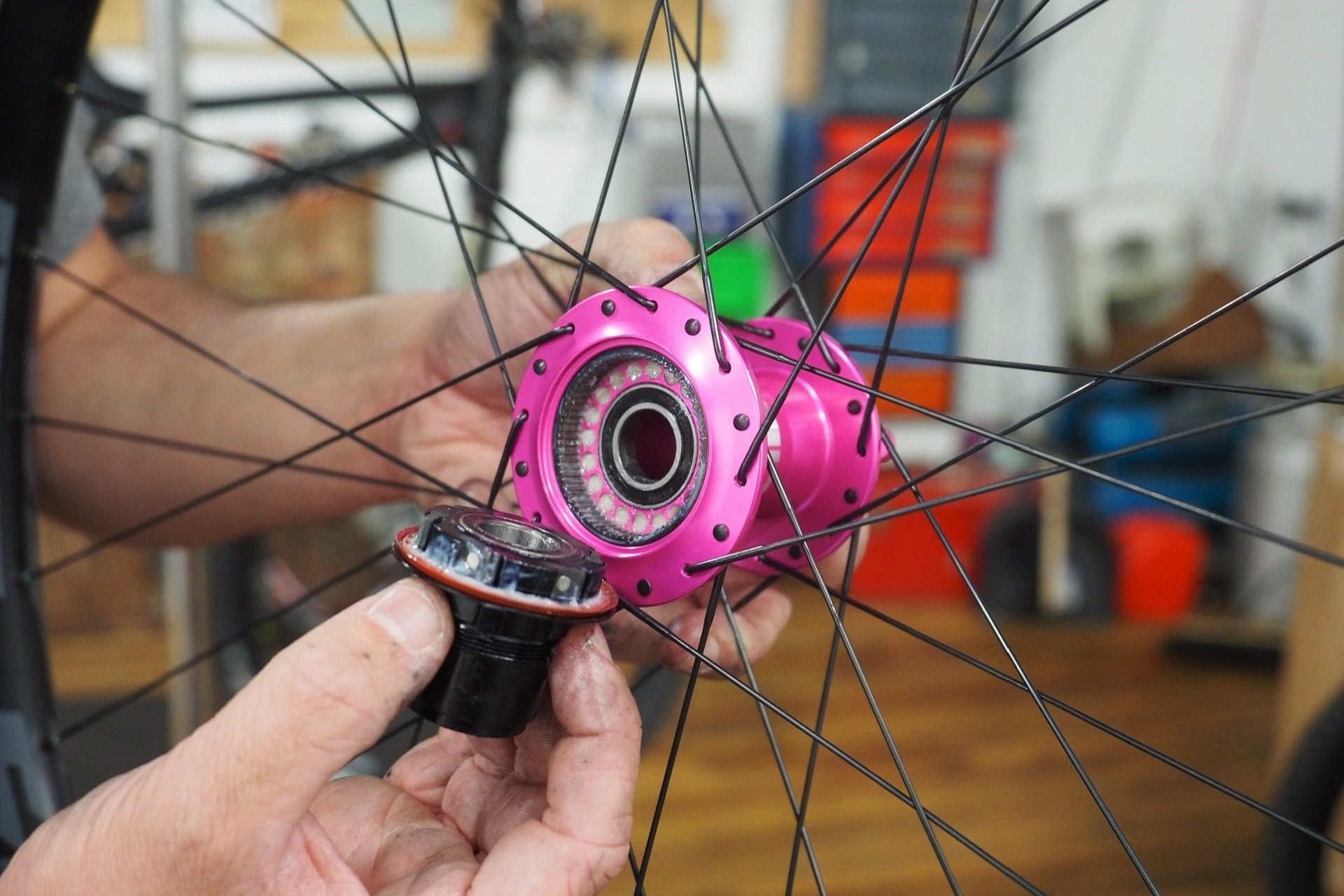
Ignoring the engagement points, what's magical about the Project 321 is just how fast they roll thanks to the magnetic pawls, high-quality Japanese EZO bearings, and the very low drag design.
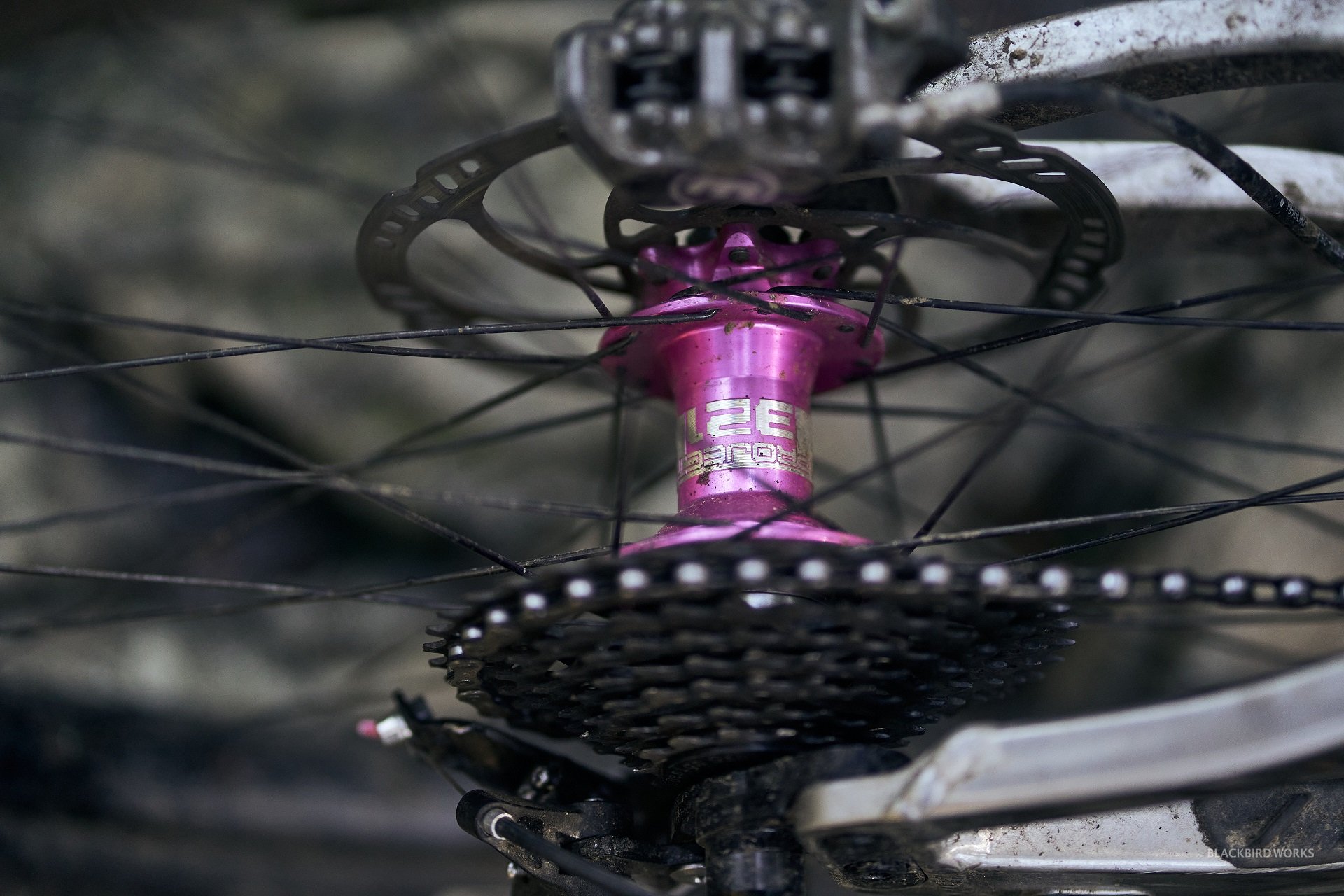
This G2 most recently spent hours on the Banshee Titan and Santa Cruz Chameleon MX that I reviewed, and it's always remarkable how effortlessly it spins. Photo: Deniz Merdano
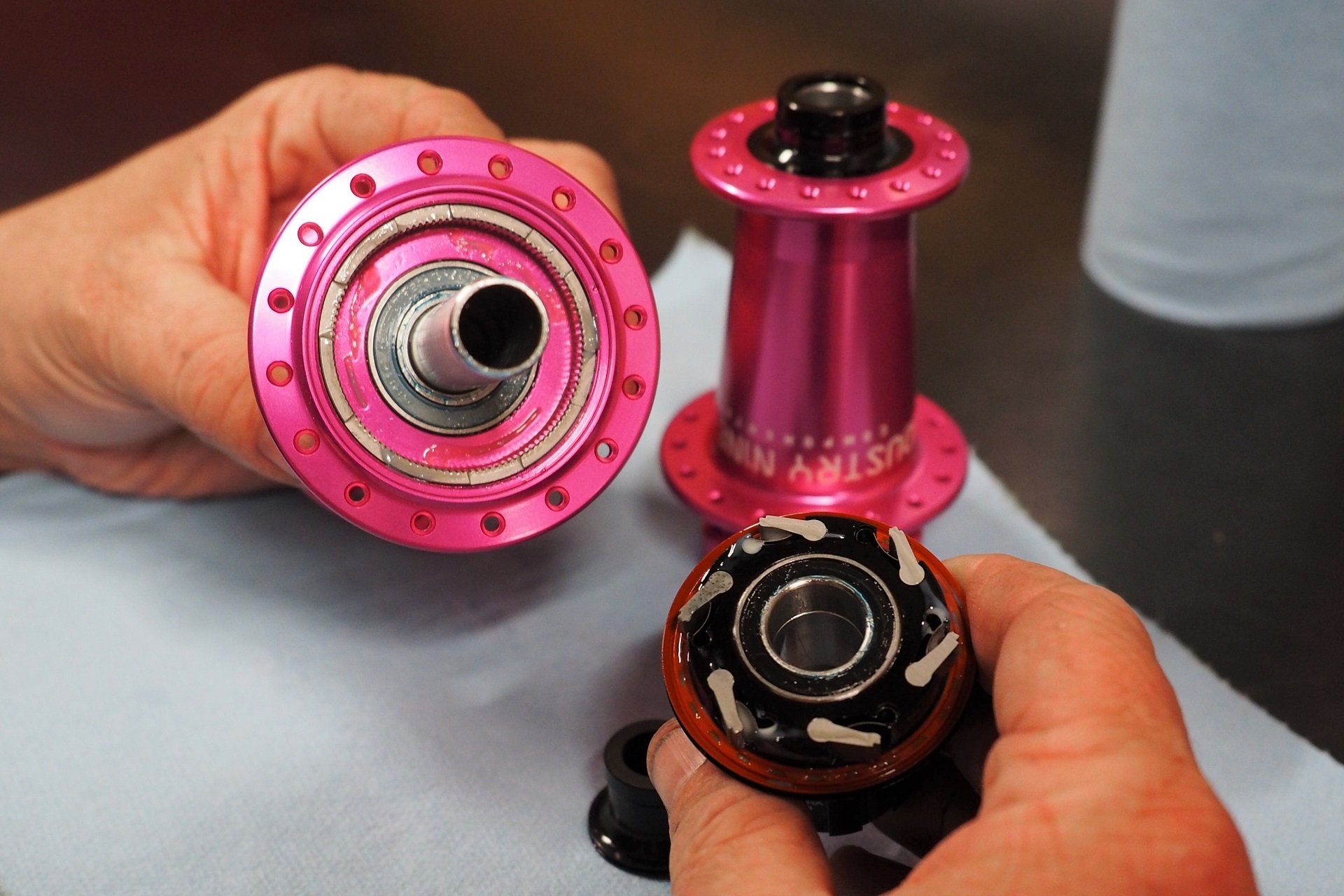
I've ridden a couple of clutch-style hubs that engage instantly, but at 690pt, 0-to-0.52°, the Industry Nine engages as firmly as anything. Even so, I'd consider anything with <5° engagement fast.
20° Of Ryan
The benefits or quick engaging hubs generally involve technical climbing or sudden power moves, which may involve slower-rolling through jank or on structures. But there's a whole other side of hub engagement I had never considered before reading Ryan Walter's treatise on the subject disguised as a We Are One Wheel review.
I borrowed some 18t DT Swiss ratchets, aired up my Industry Nine Hydra wheelset, and then went in the woods to ride chundery corners comparing 0-to-20° engagement with what's effectively instant-on. I only came to one conclusion, but it's a doozy. I'm just not f*cking good enough at riding mountain bicycles to notice the difference that a hub with a greater average rotation between engagement points makes on my suspension.
I easily resolved this issue by swapping my hub engagement experimenting over to a hardtail and with zero millimetres of travel, hub engagement doesn't affect rear suspension performance at all. Rather than looking at the suspension performance in the fast-and-steep-and-deep, I'm focused on how points of engagement influence slower-trail technical entertainment.

Does having a hub with a faster average engagement, say an 18pt DT hub with 0-to-20° engagement versus the fantastic 90pt Industry Nine 1/1 with 0-to-4° engagement affect suspension performance under hard riding, hard braking, conditions?
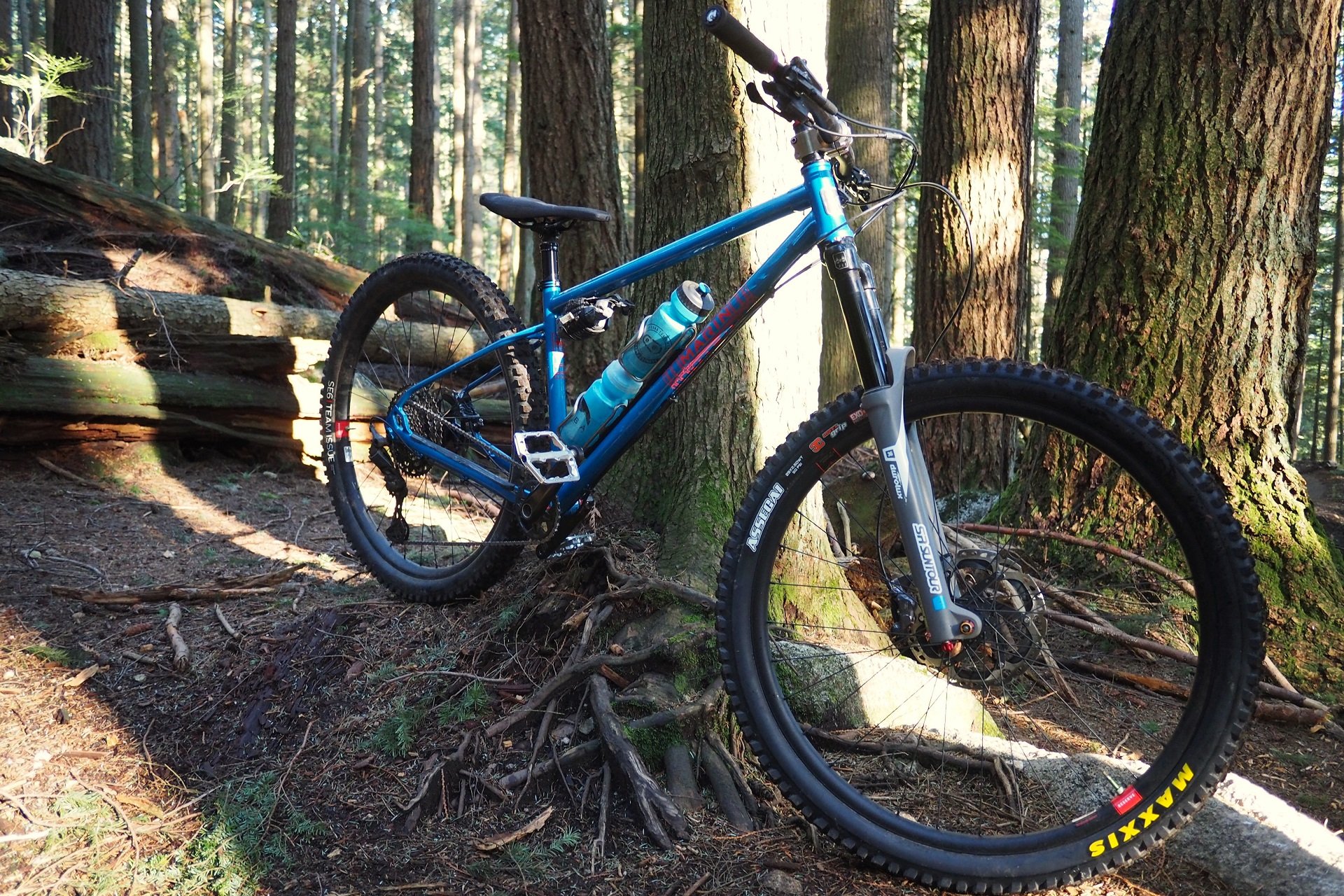
I'm certainly not a good enough rider to say either way, so I moved my experiment over to my over-forked El Roy hard tail test-mule which goes downhill plenty fast for me and has a 100% anti-movement rear suspension that's not influenced by hub engagement at all.
Ratchet Revolutions
One sentiment that comes up regularly when I talk about my love of fast-engaging hubs, is that they're entirely unnecessary when it comes to thriving on a bike in technical terrain. That is to say that riders claim that any sections they aren't making on a 0-to-10° or 0-to-20° engaging hub wouldn't go any better on a much more direct-drive option.
I have oodles of micro-specific North Shore examples where I'd lightly disagree. Riding a less precise hub requires a much more thoughtful technique and I occasionally mess-up and dab when I feel a faster hub option gives me more leeway. I need to be sure that the hub is engaged as I ride into a technical feature, which often involves pedaling in a slightly-harder gear. Any time I ratchet my pedals to clear through a bike-grabbing techy bit of terrain I need softly rotate back to a point where I can feel the hub is rotating near the next engagement point.
It's not that this stuff doesn't become second nature with enough hours on the bike, but going back and forth, I spend way more time thinking about my pedals on the 36pt DT 350 or Shimano Deore hubs compared to hubs with much faster uptake where I can just assume full support anytime I start to pedal.
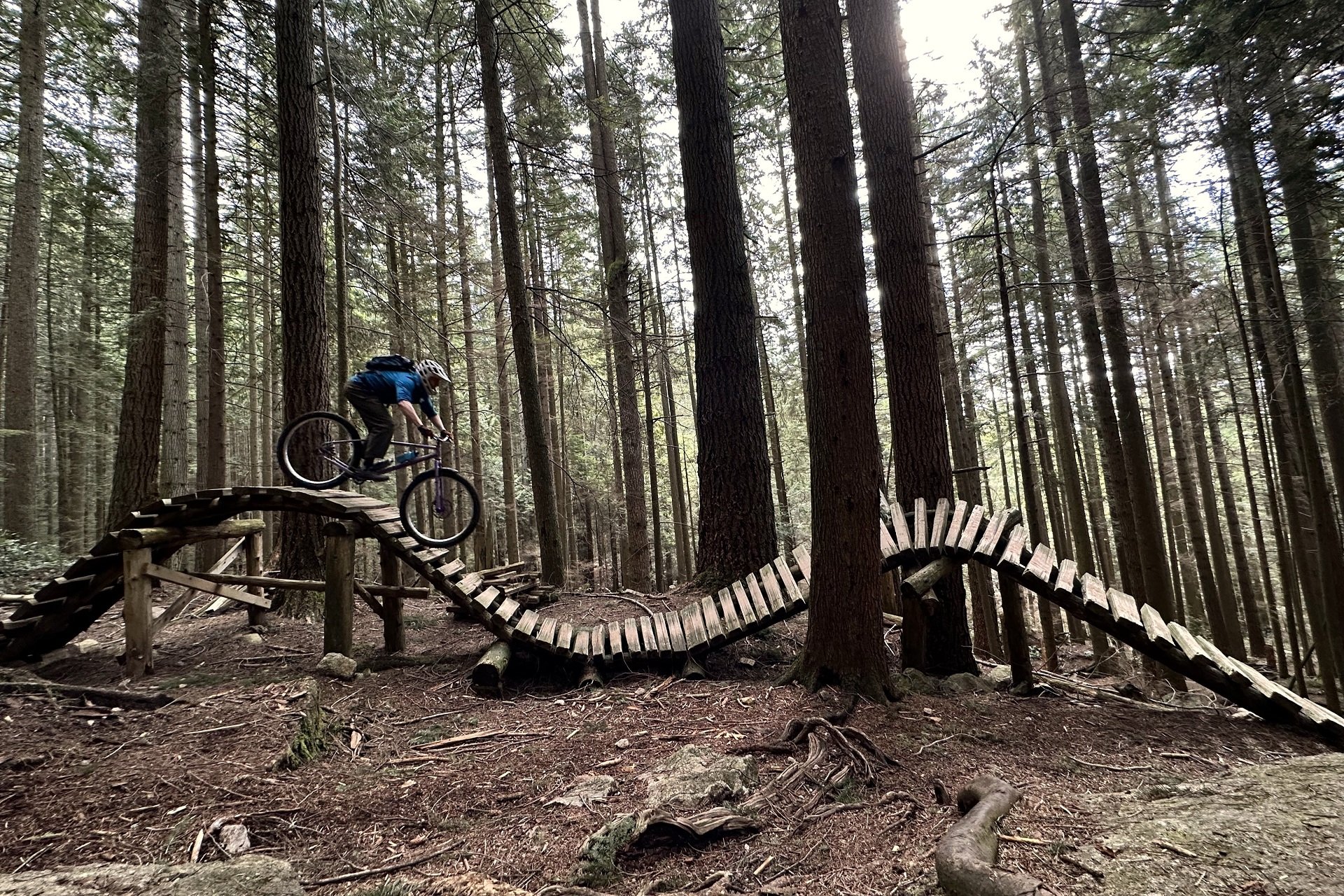
Pumping along on rollers - dirt, rock, or wood - hub engagement never comes into question, until it does. Photo: Penny
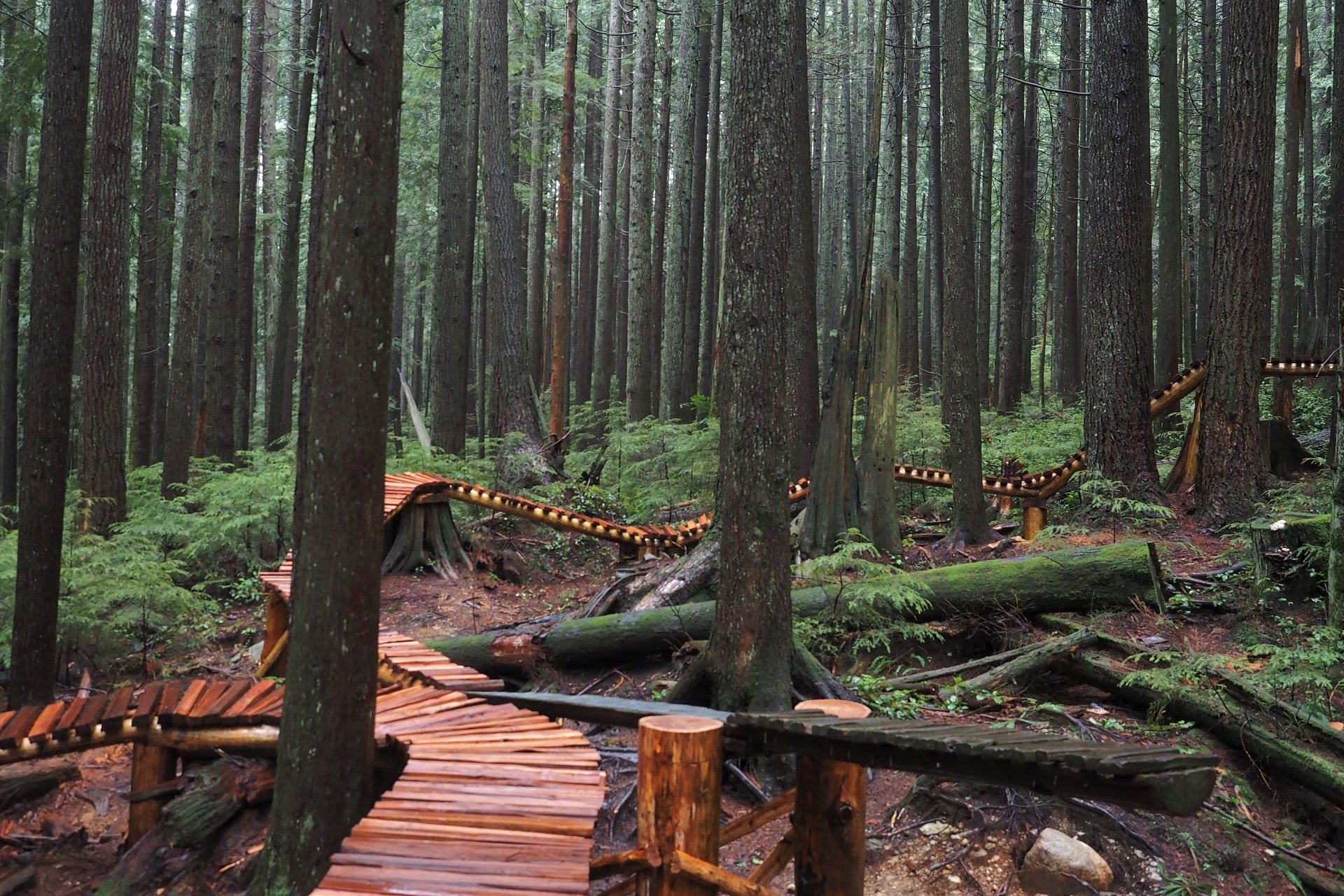
I need all the help I can get on elevated features, especially with tight corners that are best balanced with small inputs on my pedals.
Pumping along on rollers - dirt, rock, or wood - hub engagement doesn't come into question, until it does. When I mess up and need a quick pedal stroke, a fast engaging hub makes the difference between committing or shitting. The same goes for keeping my balance on teeter-totters, uphill skinnies, and narrow single-track - up, down, or across, navigating through aggressive roots or rocks.
Even so, it's quick accelerations on and into technical uphills where more exact hub engagement makes the biggest difference for me. Those moments when a quick ratcheting motion and a flawless amount of pressure on the pedals just barely squeaks the front wheel through a steep uphill switchback. Or when a full-body-burst, timed with a rare perfect pedal stroke, boosts me up and over a gnarly root section from a near standstill.
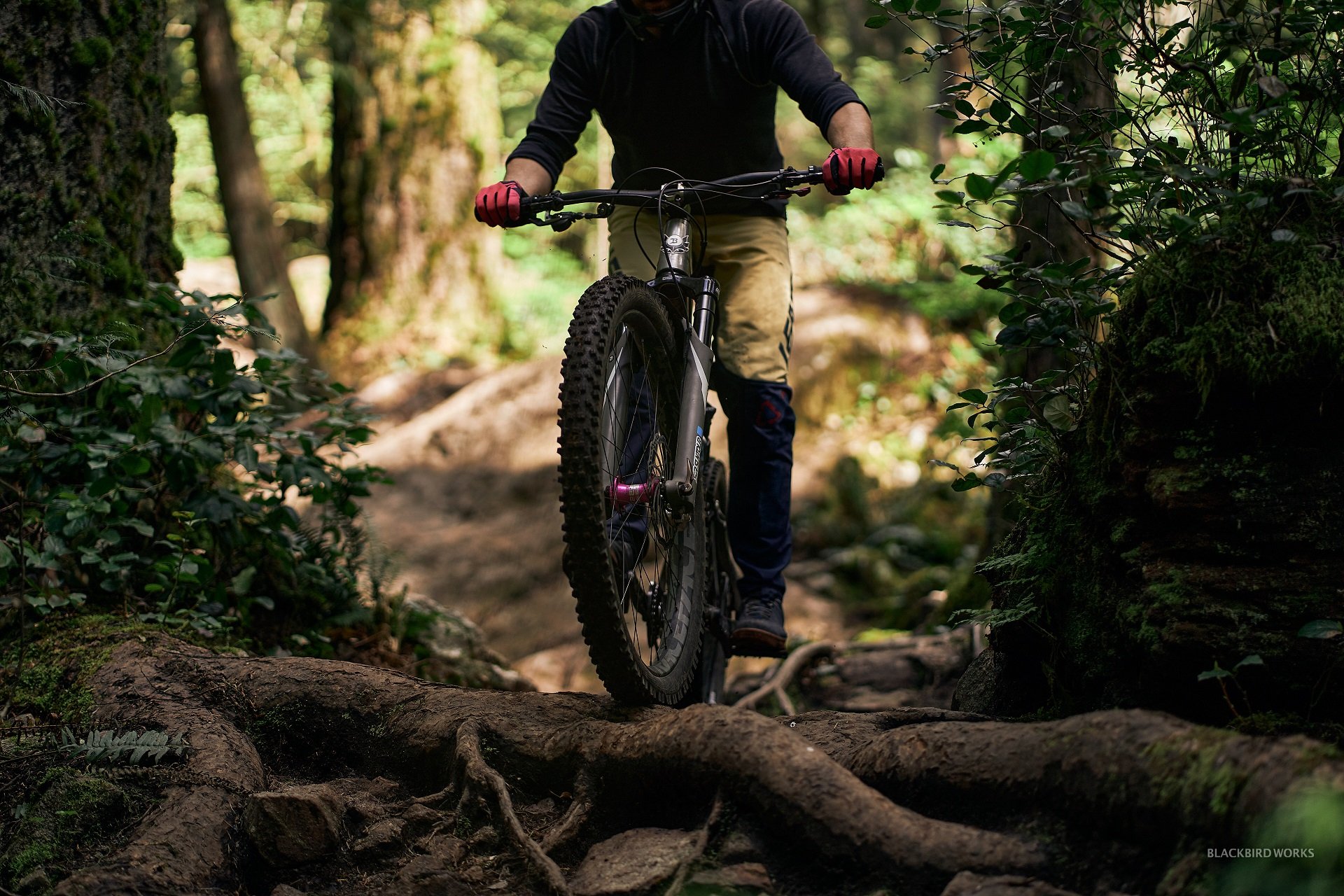
Okay, I fibbed, there's a bit more full suspension content. Full-squish or rigid, ratcheting through roots I'm always much smoother with a more instantaneous engagement. Photo: Deniz Merdano
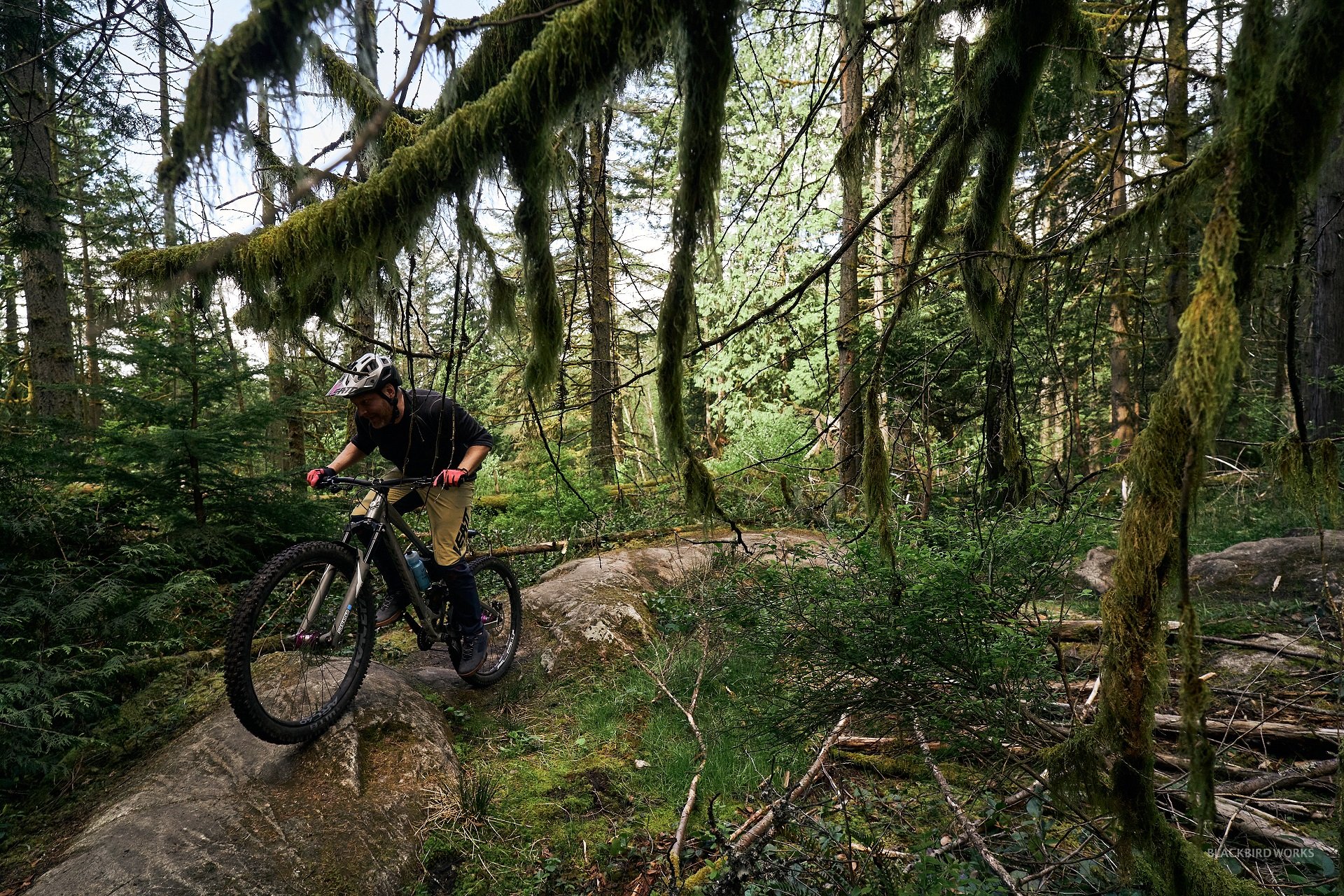
That's even true on a long travel bike like the Banshee Titan where the active rear end and long rear center provide endless climbing traction and smooth out undulations in the terrain. Photo: Deniz Merdano
I love trying those sorts of uphill power moves, and that's doubly true when I push on my pedal and my bike near-instantly starts to go while I can keep my brain fully focused on the task at hand. Or, at least if there's spare brain power it's being used on important parent-ride multi-tasking - like what I'm making for dinner.
I always have fun riding mountain bikes, but I generally have more fun riding mountain bikes with faster-engaging hubs which is why I continue to direct folks towards them.
That said, with the right focus and technique I'm not claiming there's any magical skill-boosting going on. Just an increased margin of error that has me making sections the first time rather than having to hike back up for a do-over.
Height - Steve Buscemi-ish
Wait - Patiently
Ape Index - T-Rex
Age - The same as DOS
Favourite Trail(s) every week - Pipeline (thank you Ken!) to Lower Crippler (thank you Andy!)
Favourite Song(s) this week - I'm Your Man. Nick Cave (covering Leonard Cohen)
Favourite Colour - Cosmic Lilac
Bar Width - It depends
Reach & Stack & ETT - It depends
Crank Length - 175mm except when it's 170mm
Wheel Size - Hot For Mullets


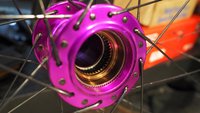
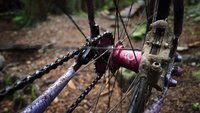
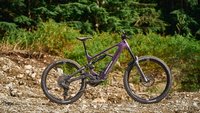
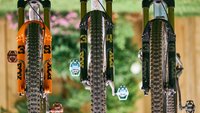


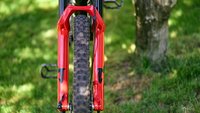
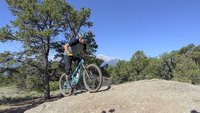
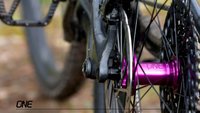
Comments
JT
1 year, 1 month ago
I prefer tighter engaging hubs. This gets proven out every time I switch the roadie's wheels out from winter to summer weights. The summer wheels have about 10d of action, and that bang of the pawls engaging riding over potholes/roots/rocks while still pedaling just bothers the heck outta my aesthetic sensibilities.
But that's superficial.
The real reason I prefer quicker pick up is in past times working in shops and the industry, I noticed that slower hubs tended to have more ratchet/pawl/freehub failures. My thinking is that the looser the engagement, the harder the contact the pawl makes with the ratchet in certain scenarios. Think of it as taking a 16oz hammer, raise it up a .25", and then drop it on your thumb. Ouch is a maybe. Now take that hammer and raise it 2" and do the same. That very well may smart a bit. The tighter the engagement, the less uninhibited momentum buildup there is before the pawl interfaces with the ratchet. The lighter the impact force, the more stable the whole system is. I think you'll notice that slower engaging hubs will tend to bear witness marks from contacting the ratchet ring. Granted, internal bearing placement between the hubshell and the freehub also plays into that.
At some point I do want a set of either Onyx or Box clutch hubs. The silence is golden, the engagement the tightest, and if it means hoping on the OChain train for the susser, I'm ok with that.
Reply
Andrew Major
1 year, 1 month ago
"My thinking is that the looser the engagement, the harder the contact the pawl makes with the ratchet in certain scenarios. Think of it as taking a 16oz hammer, raise it up a .25", and then drop it on your thumb. Ouch is a maybe. Now take that hammer and raise it 2" and do the same. That very well may smart a bit."
That's very interesting. Aside from the excellent DT Swiss star-ratchet hubs, all the really high-end hubs I've dealt with have been fast engaging ≤5° so I've always equated durability to quality. But, riding the Roscoe especially (Shimano 10° hub) I've had a couple of HARD engagements lately and reasonably that would be much worse for the hub.
Is silence golden? I've ridden Onyx Classic* and True Precision clutch hubs and I think both products are excellent but the engagement on a functionally instant 0.52° Hydra hub is much more firm and precise. Plus the Hydra is much easier to service and a bit of Dumonde Tech freehub oil makes the noise more pleasant than tinny.
------
*From my experiences turning wrenches I can highly recommend buying the Classic and also recommend against buying the Vesper hubs from Onyx.
Reply
KirkS
1 year, 1 month ago
“From my experiences turning wrenches I can highly recommend buying the Classic and also recommend against buying the Vesper hubs from Onyx.”
Andrew, is your experience with early Vespers or more recent ones? Any other impressions beyond go/no-go?
I recently acquired a used Onyx Classic and am loving the silence, and also the instant but gentle engagement. It is not on may main ride though, which I am now entertaining the idea of rebuilding the rear wheel with a Vesper once funds allow.
Reply
Andrew Major
1 year, 1 month ago
I guess the follow-up question would be how recent are the "more recent ones" that you're referencing? I've worked on quite a few Vesper hubs and the only notable difference from one generation to another that I've noted is the axle preload system.
Regardless of the generation of axle/preloader, again from hubs I've worked on, neither the drive system (clutch has significantly less surface area) or the bearing setup is as robust and survivable as the Classic. Particularly the non-drive hubshell bearings wear out very quickly even with higher-quality options installed.
I know a couple of riders who loved their Classic hubs such that after having repeated issues with the Vesper they went back to running the Classic rather than switch to another brand. Which I think says a lot. If you are going to buy another Onyx, why not stick with the Classic?
Reply
KirkS
1 year, 1 month ago
Re: follow-up question, I just heard the original axle/preloader was problematic. The only reason I was thinking to go with Vesper versus Classic is weight. I’ve been running DT 350 since forever and they are nice and light. But I love quiet more than saving 200g.
Reply
Blain Echols
1 year, 1 month ago
I love the quiet. I've had a Vesper for a couple years now with no issues. N of 1 and all that, so it's worthless info for reliability. Interestingly, I really did not care for the pedal feedback with the instant engagement on my older FS bike (Intense Primer first gen) so it got moved to the singlespeed and I LOVE it in that application.
I just built up a new FS and really wanted the Onyx quiet, but without the totally instant engagement and dear price. I'm trying XTRs, and feel like it's a decent compromise on engagement and noise. I'm worried about reliability, though. P321s with quiet high-torque pawls would've been high on my list if they were available.
Andrew Major
1 year, 1 month ago
@KirkS, I know some folks found the original preloader tricky to setup but as long as you clamped the wheel into your frame first and then set the preload it was fine? I’ve seen that drive side bearing die very prematurely regardless.
No system relying on a stainless steel drive shell is going to be super lightweight. I’ve heard from quite a few readers who’ve had flawless Vesper experiences but based on my own hands and eyes and customer downtime, I think the the Classic is worth the extra grams if you’re going Onyx.
Andrew Major
1 year, 1 month ago
@Blain Echols, the quiet P321 pawls where a good compromise. I have some prototype pawls (don’t think they ever made production) in my Pink G2 hubs that split the difference between loud and quiet and that’s my unicorn. Always thought it was nifty that they had options though.
I like the loud pawls on my commuter (single speed hub running 6-cogs) as I feel it extends my presence like a sound based force field.
JT
1 year, 1 month ago
I test rode a couple Onyx's on various friend's/friends o' friends' bikes and didn't really notice the windup on the trails. Trackstanding in a parking lot, sure, but nothing noticeable on dirt. As of now, I'm a bit gunshy of any hubs using billet hubshells. I've had one fail (not I9) and seen too many others as well and not just from I9. Split hubshells, busted flanges. Kinda why I'm waiting for Box to release theirs at some point as I'll bet it'll use a forged shell. I think this is one area Hope was smart: source forged hub blanks then machine em in house.
Reply
Andrew Major
1 year, 1 month ago
I notice the windup in the parking lot. On the trail, I only passively notice it on a single-speed and even then it doesn't bother me. But it seems to be one of those things where it either bothers folks or it doesn't.
I have yet to meet someone that's switched off of an Onyx hub because the windup bothered them but I've met a few people who didn't buy them after trying a friend's.
Reply
mikesee
1 year, 1 month ago
I've always been engagement agnostic: I notice it but don't care, and don't believe it matters in any way.
But noise -- man I cannot abide noise when coasting.
I think the much discussed windup on Onyx Vesper hubs -- especially when in my 24t chainring up front and 52t cog out back, winching up something ridiculously steep -- equates to a sort of traction control. Much less likely to slip or spin as you pause or slow your cadence and then burst to get up/over something.
The silence got me interested in Vespers. The Traction Control has kept me there.
Reply
hankthespacecowboy
1 year, 1 month ago
Amen to the "Traction Control" aspect of Vesper hubs. I recently started a riding a Vesper-based wheelset; at first I was a little bummed to find that the instant engagement wasn't as noticeable as I was anticipating, but soon realized it was more akin to the traction-enhancing effects of hydrostatic transmission v. trying to feather clutch engagement on a manual transmission.
Velocipedestrian
1 year, 1 month ago
I tried an Onyx for the first time today. I knew I'd like it, but man...
Almost glad they're comically far from what I'll spend, rather than close enough to talk myself into.
Reply
Andrew Major
1 year, 1 month ago
Classic or Vesper?
From the feedback here I think it behooves me to get a bunch of local hours on a Vesper myself on local trails/through a properly wet and greasy Shore winter.
Lynx .
1 year, 1 month ago
Yeah, same thing for me. Hard to justify any of those higher engagement/more bling hubs when I can pick up a set of Hopes for probably 2/3-3/4 the price of one rear and that proposition to me gets even better now with the new Pro5 with 104 POE and the same pricing it's looking like.
[quote=Velocipedestrian] Almost glad they're comically far from what I'll spend, rather than close enough to talk myself into[/quote].
Velocipedestrian
1 year, 1 month ago
Classic.
jeffp
1 year, 1 month ago
Onyx hubs - some folks love 'em, some folks hate 'em. While many of the perceived benefits (and faults) are aesthetic: silence, 'instant' engagement, I think there are some performance benefits, but they don't flow from the engagement (which with compliance, is small but not zero) - they result from the compliance itself.
One benefit of the compliance is a smoother application of torque, which I find reduces spin-out in loose or slippery situations. Some of your pedal pressure is stored elastically in the steel spragues and released as the torque falls, averaging out torque peaks, especially in low gears when the torque at the hub is highest. I've found this to feel similar to the effects of an elliptical ring, or a laterally compliant frame, and combing all three makes a very smooth bike indeed.
The stored energy for me also benefits pedaling efficiency like a compliant frame does. It almost feels like I dropped a tubing size on my rigid steel with the Onyx hub.
As to the durability of the Vesper, I'm not a heavy or powerful rider by any stretch of the imagination, but I do put in a lot of miles. My oldest Vesper I've had for 3+ years, and done multiple loaded week long tours on and off road in Vermont, North Carolina, Arkansas, New Mexico, Colorado, Idaho. No failures. Same hub sees year round daily commuter duty (admittedly in Denver, not your rain forest, but it sees plenty of studded snow riding here) . We now have 3 Vespers in the family, and I have yet to have a failure. So they work for me and my family in our usage.
Reply
AndrewR
1 year, 1 month ago
And six dabs of Dumonde Tech grease (after a good clean every 500 km) makes I9 Hydras tolerably quiet.
Reply
Andy Eunson
1 year, 1 month ago
That’s been my take too. These days though, hubs with slower engagement tend to be cheap lower quality hubs. I think back on the freewheel failures we had in the early 80s. Two pawls maybe three I don’t recall how many degrees of engagement they had but they did slam into engagement when you ratcheted through janky trails. Shimano freehubs on the 80s and 90s were all two pawl varieties which failed regularly partly because the drive side seals were not good at all and partly the two pawl 18° (?) engagement.
For me a certain degree of engagement like my 1/1 hubs, Torch or whatever the Bontrager hubs offer is fine. When I bought my Trek in 2019 it came stock with three pawls so after a couple months when I serviced the hub I bought the extra pawl kit for a few bucks and halved the engagement. I didn’t notice.
It’s similar to boost hubs being stronger. Or cassettes having a wider range. If you don’t need it or notice it it doesn’t matter. More engagements than we had in the 80s is good. But at a certain point it makes no functional difference. It might be noticeable but it might not be functionally better.
Reply
JT
1 year, 1 month ago
I recall my old Mavic 571 hubs. I blew up three freehub bodies in one summer and retired em from offroad duties after they told me the last warranty was the last one they were gonna give me. Never had an issue with Hugi or the White Industries hubs I had. There's much to dive into beyond just engagement, as DT proves out time and time again by having the only hub that seems to suffer when the degree of engagement decreases.
Reply
Justin White
1 year, 1 month ago
"uninhibited momentum buildup" <-So good.
Based on my own experience smashing the pawls on low PoE hubs to nubbins, I have to agree with the hammer analogy.
The Spanks are also multi-tooth pawls, so that is also something to consider. You don't often see multi-tooth on low PoE because the pawls would have to be pretty big and relatively heavy in order to touch more than one drive tooth at a time. But spreading the contact from just the end of a single pawl tooth has got help with durability.
Reply
Ryan Walters
1 year, 1 month ago
Thanks for writing this Andrew. After my WAO article, and some banter back and forth, I'm doubling down on my insistence that I can absolutely feel the difference between 690 pts. (Hydra) and 18 pts. (DT) during heavy braking through rough terrain. I've swapped said wheels back and forth a few times, and my suspension certainly suffers more while the Hydra is in play.
I think there are still readers who misunderstood me as saying "a low-engagement hub cures pedal kickback". I never said this, but for my riding style on my bike on the terrain I frequently ride, it certainly calms things down.
Reply
Andrew Major
1 year, 1 month ago
Cheers Ryan!
I think this is such an important takeaway in any product review and we need to always be hitting on it:
"...for my riding style on my bike on the terrain I frequently ride..."
And also, take inspiration where it comes. I would not have written this piece if it weren't for your submission and our subsequent conversation - so thank you.
Reply
IslandLife
1 year, 1 month ago
Yep... and for me, I've found that around 4 or 5 degrees to be a good sweet spot. I like to ride a lot of double black+ lines. Love high engagement for slow technical precarious situations which mostly happens getting into said lines... getting set up and committing to a line or mid-way when there is a "unique" adjustment to be made and getting back on the power quickly to push through a sketchy section is needed.
At the same time, these lines by nature, have to ridden slower... somewhere between crawling to mid speed, at the same time, traction is paramount. And while these lines may be slower... many of them are by no means smooth and so, suspension performance is still key.
I can think of a a few sections where you're at a higher speed, but need to slow down quickly through steep chunk and navigate some precise direction changes before opening things back up again.
I have felt less confident on very high engagement hubs through sections like this... with my suspension feeling "tight" and buck-y or skipping vs gripping.
It's really these discussions over the past couple years that have made me more aware of the differences and now have reasons to put to what I didn't really understand what was happening previously.
Really enjoying my Crank Bros Synthesis with the 1/1 hubs this year. As an aside, the font wheel was quite noisy for the first few rides, but seems to have settled down and rides beautifully now... never experienced that before.
Reply
Ripbro
1 year, 1 month ago
I’m in the ‘don’t know what you don’t know’ camp. I have limited funds for bike upgrades and generally make one big upgrade per season. Last year fork, this year brakes. Next year it’s rear shock or wheels.
I’m interested to know what the upgrade hierarchy is for others. Where would hubs slot in?
Reply
Andrew Major
1 year, 1 month ago
What rear shock/frame are you currently riding? Presumably the new shock is partially covered by the routine yearly maintenance you’ll be skipping with the upgrade?
Are you riding more janky on/off trails or flowier terrain?
Craw makes a good point above about how much fast engagement mattes to him here in the Shore-to-Sky corridor and conversely how little it matters in Ontario where he’s been riding lately.
Reply
Ripbro
1 year, 1 month ago
Ripmo AF, rear shock is a DVO topaz which got a full rebuild this year. I’m curious about trying a coil rear shock, but also thinking about upgrading to some faster wheels.
I live in Alberta, but head in Fernie and Golden and but mostly ride the harder trails outside of Calgary.
The stock ibis wheels have 10 degree engagement with a HG driver. The drivetrain needs replacement next season. The current build is NX, so changing hubs could make sense if I want something lighter.
Linkglide looks great for HG, however I could save some significant weight going to SRAM HD or I could switch to microspline and get XT for a good all around setup for a decent price.
I suspect there will be some good deals on old style SRAM cassette as I think they will update their other cassettes with the new transmission architecture.
Reply
Cr4w
1 year, 1 month ago
The older WR1 Revolution wheelsets built on the slightly slower engaging I9 1/1seem like a really good reasonably priced way to get amazing carbon rims (I've been on my Converts for 3 seasons) and pretty quick engaging hubs (<4') with your choice of driver.
Reply
Andrew Major
1 year, 1 month ago
The Industry Nine 1/1 hub is one of my min-max favourites. USA-Made, great quality, much more affordable than the Hydra and anything ≤5° is a fast-engaging option.
Another hub worth looking at from a quality, engagement, and price perspective - that also comes in many colours - is the Spank Hex. They have 102pt engagement (so 3.5°) and in my experience, they hold up well and are easy to work on.
Reply
Jerry Willows
1 year, 1 month ago
haven't touched mine in 2.5 yrs... I would get the 1/1 over the Hydras even if they were the same price. Better suspension performance, less rolling resistance, less maintenance, nothing but wins.
Pete Roggeman
1 year, 1 month ago
TIRES, then brakes or fork (depending on which one is more in need of an upgrade), then the other of those two, then shock, pedals, saddle, wheels. Wheels are super important, but if those other things aren't sorted, I won't be confident on North Shore terrain. For another riding area, wheels would move up, but so would contact points (although the scale may be tipped because they're cheaper to upgrade).
But always tires first.
Reply
Jerry Willows
1 year, 1 month ago
geometry is always first....
Reply
Andrew Major
1 year, 1 month ago
Mmmmmmmm… Jerry Willows, so spicy. I mean, we both know it’s not what you meant, but for a moment there we were on the same page if only in my mind:
Great geometry and no suspension > Bad geo and full suspension every day.
I’m still going to harvest this quote for future (mis)use anyway. #JerryWillowsHatesMyBike.
Reply
Jerry Willows
1 year, 1 month ago
anything serious is always FS. Even full on XC rigs are FS with droppers now.
good geometry/bad suspension > bad geometry/good suspension
Like I said, a good bike always starts with good geometry. Can't fix a bike with suspension that has bad geo.
#jerrywillowshatesmybikeS
Reply
Andrew Major
1 year, 1 month ago
"anything serious is always FS"
There is a beautiful, wonderful, positively-childish truth about the true potential for mountain biking buried in this statement.
Thank you, and I completely agree.
ZigaK
1 year, 1 month ago
Why so serious?
:))
AndrewR
1 year, 1 month ago
On a good ride one's tyres are the only contact points with the ground so they are always priority one (on a less successful ride there are a lot of unplanned contact points!!).
Then bike contact points with the body
Then everything else depending on budget.
Reply
Ripbro
1 year, 1 month ago
Agreed, tires are important. In dry and dusty Alberta, you only long for MaxxGrip a couple times a month. Also with the way tire prices have increased, replacing a set is now creeping into major $$ upgrade territory.
Reply
Tjaard Breeuwer
1 year, 1 month ago
In general I agree, tires make the biggest difference, and are easy to change.
But..
The problem with is that it’s much harder to know what the actual performance of a certain tire is.
After all, let’s take ‘cornering traction’.
You might have read a review, but the reviewers claims of the cornering performance might not line up at all with what you will experience.
Different rim widths, riding styles and soil can really make a big difference in the cornering feel you experience with a given tire.
Same with braking traction.
Rolling resistance is a bit more objective, but not many reviews measure it, and those that do, tend not to include very many models and versions, so again, it’s hard to get that info.
Reply
Andrew Major
1 year, 1 month ago
Even the same reviewer on different bikes, or different wheel sizes or different conditions. Working on a piece on my unhealthy hate-love relationship with semi-slicks that I think can be extrapolated to other less extreme cases.
Right now I love that Rock Razor so much… never going to give it up… never going to mess around… but one wrong line in the rain (or not)…
Reply
Lynx .
1 year, 1 month ago
I gave the Maxxis SS a go a few years ago after a client ordered them in and found they didn't give him enough traction. I actually found the complete opposite, traction was amazing considering what the center tread looks like, the only drawback was that the outer knobs were too tall and basically were engaged nearly all the time at trail pressures, so kind of negated the whole SS thing - somewhat solved this by cutting down the side knobs by a good 4-5mm.
Definitely not the sort of tyre for a "lazy" person not interested in using good technique, but amazing what someone who has good technique and uses it can find grip on with these types of tyres.
Reply
Andrew Major
1 year, 1 month ago
Significantly more sensitive to rim width I find, though I also had better results with the Slaughter (can’t spell Slaughter without ‘laughter’) and Rock Razor.
2.6” Rock Razor works well on an i30 where usually I’d want an i35 rim.
It’s a hate-love relationship. Depends on the day, the trains, and trail conditions.
Lynx .
1 year, 1 month ago
Yes, definitely not a "group" of tyres to be run on a more modern, wider rim. When we got them in was around 2014 when I had convinced the 4 or 5 guys who were building bikes and I was building the wheels for to go for WTB Asym i29 rims and that's what I tried them on initially, but quickly realised they wouldn't work, put them on an i25 and much better.
Ryan Walters
1 year, 1 month ago
For our local North Shore riding, you can't beat the bang-for-your-buck performance improvement of proper tires. After that, I'd probably put brakes and suspension on equal footing - depending on several factors.
If the decision is between shock and wheels, I'd upgrade the item that is hurting the most.
For me, hubs barely factor on the list. I mean, do they spin? Good enough.
Reply
Perry Schebel
1 year, 1 month ago
^with you there. even the zerode review rig, with a poe as low as 14 (gear variable), didn't make any appreciable difference to my riding experience. back in the bad old days of big sketchy wheelie drops - when engagement / timing really DID have consequences, we coped with low poe hubs just fine. now, i'm especially blasé re: said numbers.
random: i imagine an outside observer would find the level of engagement (ha) over minutiae like this pretty amusing. we're such dorks.
Reply
Andrew Major
1 year, 1 month ago
“I imagine an outside observer would find the level of engagement (ha) over minutiae like this pretty amusing. we're such dorks.“
Pretty sure my average submission would have an appeal to maybe 1-2% of mountain bikers, never mind non-mountain bikers.
Thankfully that’s enough engagement to keep the wheels turning. Without trying to sound like a hype man I do think the comments on NSMB pieces are the most interesting and well written in the mountain bike media landscape, and the community here does a great job of presenting differing viewpoints, often polar opposite viewpoints, and feedback politely and with well reasoned, well-written counters.
I know it’s “just bikes” but it’s too bad more of the internet isn’t the same.
Reply
Vik Banerjee
1 year, 1 month ago
I've never used a low a POE hub and have no issues, but maybe there's something I'm missing by having adapted to what I have for so long. I keep meaning to try a low POE hub, but it just hasn't happened yet. Every new wheelset is an opportunity, but so far I end up buying more of what I have or swapping a existing hub over.
Of course if I do get to try a low POE hub and love it that'll be annoying given my existing hub investment. Maybe it's better not to know? ;-)
Reply
Andrew Major
1 year, 1 month ago
HAHAHA. You know that at the end of the day, Vik, mountain biking is a consumption-driven activity, right? If you're not burning piles - mounds even - of cash chasing micro-improvements to your experience then how can you be sure you're maximizing your net fun?!
Reply
Vik Banerjee
1 year, 1 month ago
True, but I don't want new hubs to cut into my frame bag and fender acquisition program! ;-)
Reply
Andrew Major
1 year, 1 month ago
When you consider the value proposition of those multi-function fenders/anti-theft devices I guess it’s hard not to want to spend all your allowances buying more?!
Reply
Brian Tuulos
1 year, 1 month ago
I was a die hard shimano '10 degree is good enough' hub guy for years. Then finally jumped in feet first to an i9 hydra with I believe 0.5deg of engagement. So a 20-fold improvement. For me, it's not revolutionary. There are times during teck moves where I feel its an advantage, like if I ratchet up a stunt instead of pedalling circles, but not a game changer. Your mileage may vary.
Reply
Justin White
1 year, 1 month ago
Have you gone back? That's what really hit it home for me: going from back from 102 PoE to 18 PoE while waiting for wheel build. The inconsistency of the low PoE meant I was blowing feet off and breaking traction simply because I couldn't reliably pressure the pedals as quickly and/or powerfully whenever resuming pedaling after a pause or ratchet or whatever. With the tighter engagement I consistently get feedback from the rear wheel, and rest of the bike, through my feet much more quickly, and that's a big deal.
Reply
Velocipedestrian
1 year, 1 month ago
I don't think the rear suspension improvement will be dramatic on the Sirius Squad.
Reply
Andrew Major
1 year, 1 month ago
You never know!? Fast engagement and chain torque may cancel out frame flex? (Hahaha)
Reply
Dan Lees
1 year, 1 month ago
I have spent quite a bit of time on DT Swiss 370 3 Pawl 36T hubs, Hope Pro 2/4s and some Superstar (rebranding Joytech?) 102 POE hubs. My 2 cents...
The DT Swiss hubs feel like they have bit too much lag in them when I switched to them but soon got used to them. Found I had to ratchet back further for those tricky janky climb sections.
The Superstar hubs amazing on the hardtail but could definitely feel the pedal kickback on the full suspension bike.
Hope Pro 2/4 - engagement is sufficiently better than the DT Swiss hubs than ratchety janky bits are less pot luck...but still loose enough that pedal kick back is significantly reduced. Probably my happy place.
One thing I have found is that going to flats, I'm less reliant on fast engagement on techy climbs as I feel like I have more room for error and bail out later as the threat of not unclipping and toppling over sideways (due to "play" in my knee) has disappeared. That might be just me though.
Reply
Justin White
1 year, 1 month ago
"and a flawless amount of pressure on the pedals"
Ding!
This is one of the big things that many people miss when talking about PoE. Whenever traction is at a premium, that uncontrolled free spin of the cranks and subsequent smashing in the pawls of low PoE is a recipe for breaking the rear wheel loose, spinning out, and dabbing at the least if not smashing a knee on a control or taking a stem to the gut. Being able to just stand up and stomp any time, without your foot potentially free-falling for a few centimeters, is just so powerful, and makes everyone better! Like you said, most riders can (and will) adjust to it, but low PoE is always going to require more thought for that kind of riding, and thinking takes energy.
Reply
Ryan Walters
1 year, 1 month ago
I understand the point you're trying to make, but this just does not pan out in my real world experience.
There is a lot more nuance to what is going on with the rear wheel than "low POE is always going to require more thought for that kind of riding".
Also, I'm having trouble wrapping my head around the statement: "Being able to just stand up and stomp any time, without your foot potentially free-falling for a few centimeters, is just so powerful, and makes everyone better!"
On pretty much every trail I enjoy, if you stand up and stomp any old time, you will die.
I take it you mean "while climbing", but this is certainly not "any time".
Reply
Justin White
1 year, 1 month ago
Yes, there is a lot of nuance, that's why I didn't say high PoE is always better for that stuff. But low PoE is always less consistent when the power comes back on, and that's the point.
The stand up and stomp goes more towards the extra thought-load than actually pedaling power-squares at random times. Mostly climbing for most people, I suppose, but applies also if you need to intermittently pedal through a janky slippy traverse, or accelerate through a janky exit from a tight slow corner.
The point is that when to do need to get back on the power strongly, the inconsistency of low PoE means that you sometimes have literally zero feedback as to those all-important nuances of what the rear wheel is doing. Meanwhile, your foot is accelerating, so when that feedback is able to be felt when the pawls catch up, you'll probably need a power correct. That delay and the corrections take time and thought and effort.
Reply
Ryan Walters
1 year, 1 month ago
All good! But it's absolutely clear to me we have drastically different riding styles, and ride in very different terrain.
Reply
Pete Roggeman
1 year, 1 month ago
On a review team full of people that like riding terrain that is not only steep but relentless and steep, Ryan probably spends a greater proportion of his time ripping steep terrain than anyone else. So steep and so relentless that the times you need a pedal stroke to power over something might be once or twice per ride - the rest of the time you can just let off the brakes for a second to grab that sweet momentum.
Almost everywhere else - like 99%of places MTBs get ridden - it doesn't work quite like that. SO it's a good and nuanced conversation but if it sounds like Ryan's being stubborn, he isn't - he just rides really fast on really steep shit ALL of the time.
Reply
Ryan Walters
1 year, 1 month ago
I think the dual 220mm rotors might be a give-away ;)
And Pete is absolutely right - horses for courses!
Reply
JVP
1 year, 1 month ago
This comment has been removed.
Justin White
1 year, 1 month ago
Really fast on really steep is one place where PoE doesn't really matter at all. Low doesn't hurt or help, and high doesn't hurt or help. I'm not trying to say that one needs high PoE if they only ride fast and steep, I'm just trying to say that low PoE sucks on more other types of terrain.
In other words, low PoE is the worse horse for more courses.
Reply
Karl Fitzpatrick
1 year, 1 month ago
Wait just a damn second. You made me Google how tall Steve Buscemi is now I'm wondering if I could, in fact, manage an El Roy at 172cm tall.
My ape index is in the other direction though ie. More gorilla but only in length, not girth.
What say you, Major?
Reply
Andrew Major
1 year, 1 month ago
172cm?! Haha, you just made me convert that to feet. In Canada don’t we all measure smaller things in centimetres, rooms and people in feet, and long distances in kilometres. Unless we’re exaggerating an effort in which case it’s miles?
Personal preference in terms of whether you’d like the fairly long standing position, and maybe you’d run a 31mm stem, but you could definitely fit an El Roy. I should probably throw in some caveats about bar width and crank length but with gorilla-arms you’re good.
My recommendation for testing hardtails, if there’s a local dealer around with one you like, I’d to take a couple rubber straps along. Try out the bike (parking lot is fine) with the fork pulled down to 50% sag and closer to bottom out to make certain the growing reach is manageable everywhere in the travel.
Reply
Cr4w
1 year, 1 month ago
I had a set of Hope Pro 4 wheels and I liked them a lot less for Vancouver riding after I got Hydras. But now that I've been putting in some miles in less extreme less ratchet-requiring places I can see how people could get on with lower engagement hubs. For sure on my gravel bike.
In Vancouver what I didn't like about the lower engagement hubs was the feeling of the hub almost falling into drive mode. There was a split second where I'm building up momentum, like taking the slack out of a tow rope, which I strongly disliked. In the olden days that momentum killed many freehub bodies.
Reply
Andrew Major
1 year, 1 month ago
“In Vancouver what I didn't like about the lower engagement hubs was the feeling of the hub almost falling into drive mode. There was a split second where I'm building up momentum, like taking the slack out of a tow rope, which I strongly disliked.”
This sums up my experience very succinctly as well. I find myself shifting much more so I’m in a gear I push into and also doing backwards micro-ratchets to try and find an engagement point before I start pedaling.
Reply
Cr4w
1 year, 1 month ago
My experience is probably exaggerated by riding a very long wheelbase bike with 175mm cranks. I'm super conscious of trying to limit pedal strikes so I probably ratchet a lot more than the average person so I really notice the lag in hub engagement. I've been riding in Toronto for the last month and I couldn't care less.
Reply
Andrew Major
1 year, 1 month ago
I do also tend to ride 175mm cranks and fairly low bottom brackets and/or long rear centres. Good point about more ratcheting being required.
Reply
Justin White
1 year, 1 month ago
Long Crank is colluding with Big Hub to keep high PoE in demand!
Reply
Kenny
1 year, 1 month ago
Yeah, I recently went from a 1240mm wheel base to 1300mm and was surprised by how much lower the bottom bracket feels particularly tech climbing. It makes sense but it just hadn't occurred to me before.
With more distance between the axles it seems much more necessary to ratchet, but you also have more time/space to do it.
I initially reduced sag to try to compensate for the low feeling BB but the bike just did not feel as good. Embracing the ratchet has been worth it, and faster engagement definitely makes multiple quick short ratchets easier for me personally.
Of my three bikes, hardtail has hope pro 4, 44poe, the long bike noted above has vaults at 120, and my "spare" bike has I9 at 690.
The 44 feels much slower and harder to micro-ratchet than the 120 and the 690, which to me feel basically the same. So for me the change from 44 to 120 is far more drastic than 120 to 690.
Reply
Kos
1 year, 1 month ago
The only place I notice is in rocky tech terrain like Moab. Engagement doesn't really matter for me in terms of making moves, but faster engagement in that arena just gives the riding a more elegant feel.
Reply
Andrew Major
1 year, 1 month ago
That’s a nice way of describing it - elegant vs. clunky.
I do find that riding the less elegantly engaging setup I have to focus more more on when I’m going to ‘hit’ the gear - being certain I’m pedaling into the engagement point or micro-ratcheting back to the last one - I don’t ride as smoothly and naturally and that has me going back to re-ride sections more often. But talking to a lot of riders locally, about janky trails specifically, it’s a fairly even split between those that don’t care and those that must have quick engaging setups.
Reply
mikesee
1 year, 1 month ago
Andrew, you wrote: "I need to be sure that the hub is engaged as I ride into a technical feature, which often involves pedaling in a slightly-harder gear. Any time I ratchet my pedals to clear through a bike-grabbing techy bit of terrain I need softly rotate back to a point where I can feel the hub is rotating near the next engagement point."
Not quite sure I understand -- how can you 'be sure the hub is engaged' when the engagement point is changing with every centimeter that you roll forward?
Reply
Andrew Major
1 year, 1 month ago
Yeah, apologies, in my mind it was really clear but re-reading it there's definitely something to be desired.
Say, I'm rolling up to a feature that requires a sudden pedal input, but where it's not possible to keep the cranks turning and the hub engaged. Instead of pedaling forward and having my foot/pedal fall the distance to the next engagement point, I'll micro-ratchet backward to try and catch an engagement point where my pedals are still in a more ideal position to create power.
Not to sound too chuffed on myself, but I've become quite adept at pulling it off fluidly with the DT 350 36pt hubs unless I spend too many days in a row on my 1.66° P321 hubs (I run one on my commuter - a single-speed version run with 6-cogs - and currently on my single-speed) and then there's an adjustment process again.
Reply
Flatted-again
1 year, 1 month ago
It’s probably not a consideration for most here, but I try to avoid hubs that trigger my rattlesnake flight response. Seems like it was really the i9 torch that did it, but I’m still wary.
Reply
Andy Krull
1 year, 1 month ago
I've been consistently on high engagement since 2000 due to trials interests. Recently made a brief swap to 18T DT hub. I found that unrideable. It was dangerous for shore riding IMO; knee to stem happened too often due to unpredictable engagement (is it 0 or is it 20 degrees?).
I've been on CK for most years, but now swapped to hydra. I didn't think I'd notice a difference, but 5 degree to 0.5 degree is noticeable.
I'm not convinced high engagement affects suspension performance other than corner cases. You'd have to be moving pretty slowly and have a large variation in CS length throughout bobbing travel for that to occur IMO. Never experienced it myself, but I typically ride horst-link bikes with limited CS length change.
Reply
Andrew Major
1 year, 1 month ago
No doubt that 5° to 0.52° is noticeable, I just find going back and forth between a variety of hubs in that range that it's exponentially less notable than the gap between 5° and 10°.
Reply
BadNudes
1 year, 1 month ago
Agree 100%.
You touch on it here, but my recent engagement revelation was down to gearing - hub engagement is not likely to matter much if you're mashing a high gear, but when geared low it can make a huge difference.
And on a full suspension a low engagement hub can still give just as much kickback depending on where the ratchet is positioned when you lock up the wheel or dorp to falt, albeit less frequently. I prefer the consistency or predictability of a high engagement hub there too.
Reply
Andrew Major
1 year, 1 month ago
This is why I’ve started writing about engagement in a zero-to-degrees format. I think it’s a more accurate way to think about hub engagement and better illustrates that consistency is a factor maybe has much as instantaneity.
Reply
jeffp
1 year, 1 month ago
That's another plus for the Onyx and Stealth hub types - consistency. Engagement comes on smoothly and always as soon as you start pedaling - growing to full torque the same way each time. You're never caught an indeterminate distance between pawls. The Hydra comes close to this with how it uses compliance in the ratchets to engage first one pawl, then another and another as torque grows.
Reply
Andrew Major
1 year, 1 month ago
It might be that I push a bigger gear than most folks (single speeding or on my geared bikes due to #1FG conditioning) but in my experiences, including with sprang and roller clutch hubs, nothing turns ON like the Hydra.
For the record, I have a number of hours on an Onyx Classic and have had bike-killer-customers who had great experiences with them, so I don’t have anything against the Onyx system I general. I’ve just worked on quite a few Vesper hubs with issues which is why I’m wary of the model Vs. a bit more weight and money.
Reply
jeffp
1 year, 1 month ago
I have seen multiple comments regarding reliability issues with early generation Vespers, but don't know what, if anything, Onyx did to address that, nor what generation your bad wrenching experiences resulted from. But the reports of problems seem to have died down. Re-engineering the pre-loader and increasing retentive force of the end cap o-rings are the only modifications I'm aware of to the Vesper. Found a good deal on a Classic just this week, so now I can run a comparison in-house. :)
Reply
Ryan Walters
1 year, 1 month ago
Proof that mountain bikers span a wide swath of experiences - I’m reading a lot of praise for the Vesper hub in these comments - and in my little niche of riders, I don’t know a single person who had an acceptable experience on that hub. Indeed, many of them blew them up. I had one on a review bike, and it was awful. The freehub had lots of friction ( right from new), to the point where the bike would sometimes suck chain from the top while coasting at high speeds (the coasting cassette would “push” chain, resulting in huge slack on the top chain). And the “spongy” feel of the engagement always felt like something was about to break. Even after a thorough inspection and adjustment from the supplier, the problems persisted.
Reply
Andrew Major
1 year, 1 month ago
It’s likely that some of the ones you saw are ones I ended up working on. I’d love to blame it on the moisture, terrain, etc of the Shore but it was too many issues/too soon.
.
Safe to say you know folks with the Classic version who have had a very different (positive experience)?
Although the soft/instant engagement seems to be very take it or leave it. Most folks I know with Classic Onyx hubs don’t notice it or look at it as a positive.
Blofeld
1 year, 1 month ago
Was the Rift Zone the bike used for hub engagement/suspension testing, or was it just a convenient fully photo? The shorter travel and moderate anti-squat on that bike may have hidden the pedal kickback on your hunt.
If you still have access to a Titan with an air shock that’ll support less-than-recommended sag, you might double the effect.
Reply
Flatted-again
1 year, 1 month ago
It must be early, because I just mixed up “Rift Zone” and El Roy” and for the life of me couldn’t figure out why you were asking about the anti-squat and kickback of a hardtail.
Reply
Andrew Major
1 year, 1 month ago
Hahahaha. All the anti-everything all the time.
Reply
Andrew Major
1 year, 1 month ago
Titan journeyed home ages ago - just a nice excuse to use those photos. Actually, few past things going on in this shots… I almost cried (and died) when the crotch in those Leatt pants failed after a couple or few hundred wash-and-ride cycles (saddle ended up hooked through a hole in the crotch). Loved those pants. And I never ride trails with an open lid anymore.
Re. Rifty, it’s the most recent fully I’ve spent time on and I ran a range of hub configurations on it, but that’s only the tip of the iceberg. I’d say that I have ridden variations of all the major suspension design and travel format combinations and enough examples of with both quick engaging hubs and longer uptake examples that I can concisely state I don’t notice a difference in suspension performance between different degrees of uptake.
I’m not saying other people don’t. I followed up with Ryan after his piece (because I’m hyper curious about most mountain bike stuff) and he’s noticing the difference between 0-to-20 and very quick engagements in specific circumstances under braking, charging, deep in his travel. Generally, at my level of skills/ability/trail processing when I find myself at that point I’m just trying to make it to the next section of trail - not thinking about how my hub being engaged is affecting how my bike is moving through it’s travel.
Reply
FlipSide
1 year, 1 month ago
I have experience with 18, 24, 36, 120 and 204 POE.
I would say 36 works well, but is the minimum for me. If I had a DT240 or 350, I'd probably be tempted to upgrade to the 54POE. I currently have 3 wheelsets based on Race Face Vault hubs (120 POE) and it's perfect. I'd certainly be totally satisfied riding ChrisKing hubs as well, as I am sure 72POE is plenty.
Reply
Andrew Major
1 year, 1 month ago
I like the Vault, 3-degrees is certainly in the fast-engagement zone. I have a lot of hours on those and King hubs and functionally the Kings are fast-enough to be in the same category.
I’ve seen & heard of too many folks having issues with the 54t ratchets to go down that trail myself. I even know at least two riders who keep extra ratchets in their bags to field-swap out the 54t. 36t setups are a super reliable option between 18t and 54t and for folks wanting faster I always recommend different brand options.
Reply
Tremeer023
1 year, 1 month ago
I moved from Hope to a Vault hub and do prefer the faster engagement. Can't say that I NEED it but given the option, it is nicer to ride (the sound, and less of a clunk when engaging).
Some people buy sports cars, not necessarily to drive at 200mph, but simply because they want a nice car.
Reply
Alex D
1 year, 1 month ago
My standard hub for short-travel bikes is Bitex at 54 POE. I'd choose more, but every high-engagement pawl-based hub sounds horrific to me. I cannot stand the angry bees thing. I'd rather listen to a flock of whining ebike motors than a single person on a stock i9 hub. (DT 240 at 54 POE isn't that much better or I'd be choosing it over Bitex. Tweaking freehub grease to quiet any of these hubs down is a temporary solution; I don't want to pull my hubs apart every twenty miles.)
Onyx is one of the only games in town for a quiet high-engagement hub, but for the price, I don't love the soft engagement (doubly so on the "light" model with more flex) or the weight penalty at the end of a suspension arm I'm trying to keep as light as possible. These downsides outweigh (so to speak) the modest benefits of tighter engagement to me.
Reply
earle.b
1 year, 1 month ago
I have been running a P321 quiet pawls for a few years then most recently i9 1/1's. An ideal hub for me would be the P321 magnet quiet pawls in that 4 degree engagement range. Damn those P321 just roll sooooo fast, they feel like they make speed somehow.
Reply
Andrew Major
1 year, 1 month ago
It's bizarre how fast the P321 hubs roll. Mine are the 2x3 version (2 pawls engaging at a time for 216 P.O.E / 1.66° engagement) and I would like to try the 3x2 version (3 pawls engaging at a time for 144 P.O.E / 2.5° engagement). Same drive ring and pawls, just a different freehub body.
Reply
earle.b
1 year, 1 month ago
Very hopeful the new G3's continue to roll as fast. I don't currently need another set...but when the time comes. Also one set closer to an all Canadian built kit.
Reply
Andrew Major
1 year, 1 month ago
Yeah! G3 hub, NSBillet cranks and ring… just need NSB to make some single-speed cogs and boom. I mean, I’ll still be getting my chains from Portugal or Japan, but it’s pretty close.
Reply
Endur-Bro
1 year, 1 month ago
Don't forget the NSB bb ;)
Also maybe add in the Vorsprung shock in development.
Reply
Jerry Willows
1 year, 1 month ago
https://www.tairinwheels.ca/product-page/tairin-r1-rear-standard-hub
interesting Canadian hub here as well
Reply
Andrew Major
1 year, 1 month ago
Very keen to check out Tairin hubs in person. I figure a pair will roll through the shop at some point and usually if I ask nice folks will let me open their stuff.
Reply
doodersonmcbroseph
1 year, 1 month ago
I currently have DT350 18T and Bontrager 108T Rapid Drive. I like the 18T because it's quiet and works just fine for me in all situations and had zero problems with weird shore tech instances. I think maybe it depends on your riding style, I think I am just constantly aware of the position of my cranks relative to the terrain unconsciously? I find the biggest difference is the noise to which I prefer not having. All my friends absolutely love angry bees so I am the weirdo.
Reply
Andrew Major
1 year, 1 month ago
“I am the weirdo”
Weird recognizes weird.
Have you tried a 36t setup in your DT? A slurry of Dumonde Tech freehub grease/oil will really chill that Bontrager hub out noise wise.
Reply
doodersonmcbroseph
1 year ago
I have not tried a 36T, mostly because it works just fine as 18T ¯\(ツ)/¯
I have tried other peoples bikes with i9 torch but never the newer 690 point hydra.
I have greased up the 108T bontrager before and it's not too bad noise wise but it doesn't stay that way for long, the DT is quiet for a longer period. I haven't tried Dumonde specifically though.
I could take 3 sets of pawls and springs out of the bontrager but I just haven't yet.
Reply
Skooks
1 year, 1 month ago
I also lack the skills to discern any negative effect on my suspension caused by my high POE hubs. I do feel like they help me somewhat on chunky, technical climbs. My test climb is Warden's trail, and I am more likely to make it all the way up on my Hydras. Although I prefer fast-engagement hubs, I could happily ride the rest of my life without them. I did manage to kill both a 54 tooth DT star ratchet and a Hydra, so I feel like the high POE hubs may be more fragile.
Reply
Andrew Major
1 year, 1 month ago
May I ask what you killed on your Hydra? Covered under warranty? I've seen a couple where the hubshell was stripped out (drivering rotating) and a couple of broken axles (I think I9 should do a steel HD axle option) but I wouldn't put either issue down to the POE.
Reply
Skooks
1 year, 1 month ago
Yeah the drive ring cracked in multiple spots. Amazingly it was still rideable. It happened pretty early on and I9 took care of me so no worries. Could have been a bad batch? I have many more miles on 2 sets of Hydras since then with no issues. I really like them, but I think the 1/1 hub is the sweet spot for price/performance.
Reply
Andrew Major
1 year, 1 month ago
Yeah, if the drive ring didn’t outlast the hub shell that says to me that someone messed up heat treating the stainless steel. Good they took care of you, definitely a manufacturing defect, kind of sucks on a hub that expensive.
Reply
JVP
1 year, 1 month ago
I’m happy at 36, but I want quiet and reliable. NO stupid bearing preload! No headaches from tinny buzzing! Not a lot of options out there for this.
Trying the Newmen Fade since their rims are amazing. 36 pt, almost silent (can’t hear them when on trail), but not easily available in N America. So far, so good.
Tairin S1 look hot!
DT 350s in 36t flavor, carefully greased, are somewhat quiet… for a while. Have those on my short travel bike.
Reply
Andrew Major
1 year, 1 month ago
One comment on bearing preload - all hubs are preloaded it comes down to whether it's adjustable or whether it's at the mercy of you tightening down your frame axle vs. how the bearings are supported inside.
I know many folks prefer a system like Industry Nine that relies on spacers vs. being adjustable, but if you ever have a chance to ride a perfectly adjusted Project 321 hub, holy heck do they spin like nothing else. So, pros and cons.
Reply
JVP
1 year, 1 month ago
Cons of preloaders outweigh the pros, for me. Not saying this is the case for everyone. I've tried very high-end hubs that most riders crown as perfect. I found them a royal pain in the ass. Lord was that a trainwreck of an experience.
There's some of us that break parts and have reliability issues at far higher rates than others. I know other gear killers who had the same experience as me with one particular brand, and hub preloaders in general. I prefer products that work well new and fail gracefully. I'll die upon this throne.
I'd be tempted to try P321 in their quiet and lower-engagement (stronger) variety. Hey, maybe they figured out a way to avoid faffing with preloaders half way through a ride. Sadly, I don't think they're planning to make this option again.
Reply
Velocipedestrian
1 year, 1 month ago
>There's some of us that break parts and have reliability issues at far higher rates than others.
So true. I used to use a gear-killer buddy as a test mule. Anything that lasted him 6 months + without issues would last forever for me. Same height/weight/trails but he just smashes stuff.
I like being on the other end of that bell curve, despite there being no obvious reason for the difference.
Reply
Lynx .
1 year, 1 month ago
Finesse and care vs ham fisted/bull in a china shop approach, that's the difference and I prefer to be to that end as well, don't like wrecking stuff just because - riding rigid does help you with this approach as well, except it'll most likely be your body you damage along with the parts.
[quote=Velocipedestrian]I like being on the other end of that bell curve, despite there being no obvious reason for the difference.[/quote]
Reply
JVP
1 year, 1 month ago
This comment has been removed.
Ryan Feagan
1 year, 1 month ago
Built up my first onyx vesper in 2020, fell in love, and Just added a third Onyx Vesper to our household. One's on my singlespeed, one on my full squish, one on the wife's full squish. So far, so awesome.
It's highly likely that I'm not sensitive enough to detect hub engagement's impact on suspension movement. But wondering: do frames with rear axle concentric pivot points/bearings make this moot? IE, Trek ABP?
Reply
Lynx .
1 year, 1 month ago
Good piece Andrew, too much emphasis placed on "super fast" engaging hubs IMHO vs good technique. Absolutely agree once the engagement is <10 degrees, if you don't make a move, more than likely it's down to technique vs faster engagement.
I wouldn't call myself cheap, more thrifty and don't like to "waste" money, so for me, the Hope hubs tick most all the boxes in that regard, decent enough engagement (the new V5 takes that to definitely), very good tolerances, ease of service, easy to swap between axle standards F&R and a decent selection of colours to help add some accents to your build. Also like that they offer backward support for products that are donkeys years old.
Little story of crap engagement hubs vs technique - made probably one of the most tech and biggest step ups when riding on my old WTB Lazerdisc hubs from early 2000s. It was a pretty steep climb on sandy, loose dirt to a big stepup of about 18" you had to turn left to get to and you started it doing about a stand still depending on trail conditions, so absolute grunt just to get to the step up and near impossible to then get up and over, but I made it with I think it's like 16 POE on those crap WTB LD hubs.
Reply
Justin White
1 year, 1 month ago
I think it's less about just being able to do it the moves, more about the hub assisting the technique, saving you a marginal bit of physical and mental energy, so you can go do more moves. I don't think anyone is really saying "I just can't do this without high PoE", but they might be saying "I'm so gassed (from dealing with that low PoE all the way up) that I can't get this one right now".
Reply
Endur-Bro
1 year, 1 month ago
Big fan of the Onyx Classics I had built onto my WA1 Agent 29s back in 2017. Recently upgraded the freehub body to XD and the new MUC style of floating axle/bearing preload/etc. I have a mullet set of WA1 DH rims that need to be built and those will also be built to Onyx Classics against the better judgement of my bank account (I know the lack of silence from other hubs will bother myself to the point that I go out and order Onyx later on 😂 also was dumb enough to go WA1 instead of EX471 or 511 sooo) I've a big fan of how easy it appears to be able to trackstand on climbs or tech sections with the Classics. Probably a combo of super slack and long geo, 83mm bb w/165mm cranks and the hub?
IIRC the Vespers save weight by going with 1.5 Sprag clutch instead of 2 in the Classic. I've seen some NOBL builds with a Classic rear/Vesper Front; but like the hubz d0nt match now.😤
I run 240s w/36 POE on hardtail, 240s w/36 on my road bike, Pro4s on old DH bike, 340s on another old bike. I find the I9 1/1 hubs on my dads bike to be annoyingly loud now.
Just waiting for Andrew to call me out for not ordering Ano Pink or Purple hubs for my next build. 😂
I'd put flashy high POE hubs pretty low on my upgrade list though.
Tyres
Grips (death to lock ons)
Brakes (ABS - anything but sram)
Dropper (finicky dropper or always needing service/bleed is a real ride buzz kill)
Saddle
Suspension (should be higher on the list but its so expensive) Regular servicing of current sus is cheap insurance though.
Wheels (lower rotational mass and unsprung mass would see larger gains from lighter tyres IMO)
Reply
Andy Eunson
1 year, 1 month ago
So my wife’s 240exp has infinite engagement. It will freewheel forward and back. Apparently DT made the ratchets, both the fixed and floating ones out of the same material using the same process as before when both ratchets floated but on the exp it lead to premature wear and the floating ratchet sticking in its toothed bore. So I packed it up for shipping to OGC in Montreal. In the meantime we found a lightly used wheel with a Hydra hub. She says it’s smoother and shifts better. She says. I can’t figure out why it might shift better though.
Reply
Justin White
1 year, 1 month ago
Maybe shifts better/different because the cable had stretched and the new hub's spacing was just enough difference to account for that.
Reply
Please log in to leave a comment.